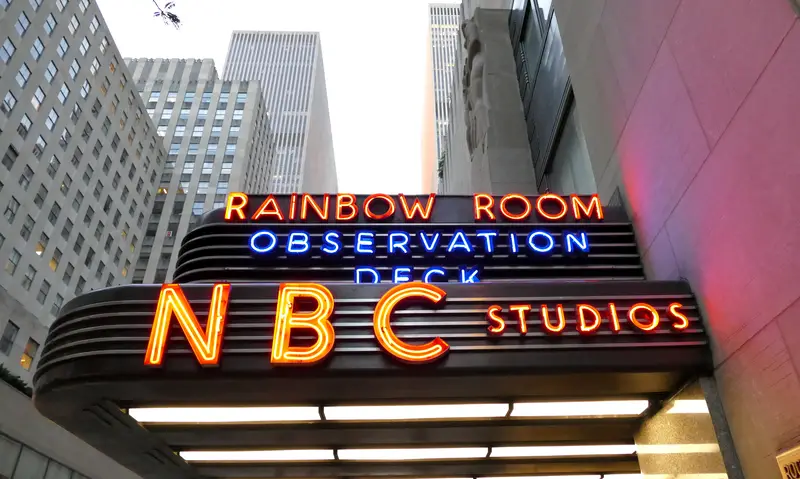Ever wonder what happens when a Saturday Night Live cast member shows up too drunk or high to perform? For Chris Farley, it meant getting banned from the show – not forever, but for weeks at a time. It might sound harsh, but SNL creator Lorne Michaels wasn’t being mean. He was actually trying to save Farley’s life. After losing original cast member John Belushi to drugs in 1982, Michaels took a totally different approach with stars who struggled with addiction. Let’s look at why Farley got temporarily kicked off the show, and who else has been shown the door at SNL over its long history.
How Belushi’s death changed Lorne Michaels forever
Back in the early days of Saturday Night Live, the show had a wild reputation. Cast members would party hard, and nobody really stepped in to stop them. That hands-off approach worked fine until 1982, when original cast member John Belushi died from a drug overdose at just 33 years old. His death hit Lorne Michaels really hard and completely changed how he ran the show. Before Belushi died, Michaels let cast members do whatever they wanted in their free time. But after losing one of his stars, he realized that approach wasn’t working.
The death made Michaels feel responsible for looking after his cast members’ well-being, not just their performances. He started seeing the SNL cast as more of a “tribe” or “group” that needed protection. When Chris Farley joined the cast in 1990, Michaels was determined not to let history repeat itself. He saw warning signs right away – Farley’s drinking and drug use were getting out of control. Unlike with Belushi and the original cast, Michaels wasn’t going to look the other way this time. The loss of Belushi had transformed him from just a boss into someone who felt personally responsible for keeping his performers alive.
Why Farley kept getting kicked off the show
Chris Farley’s problems with alcohol and drugs weren’t exactly hidden. When he showed up to work clearly messed up, Lorne Michaels would call him into his office for serious talks about his behavior. These weren’t just quick chats – they were real heart-to-hearts about Farley’s addiction issues. According to SNL writer Bob Odenkirk, Farley would actually get excited about these meetings, even though they were usually about his bad behavior. But when talking wasn’t enough, Michaels took more drastic steps to try to help the troubled comedian.
If Farley was too intoxicated, Michaels would ban him from appearing on the show for weeks at a time. This wasn’t done as a punishment – it was Michaels’ way of trying to shock Farley into getting help. Michaels figured that taking away the thing Farley loved most – being on SNL – might finally make him realize he needed to get clean. He even sent Farley to what were described as “tough love rehab facilities” to try to break his addiction cycle. Unfortunately, despite all these efforts, Farley continued to struggle with heroin addiction throughout his five seasons on the show, showing just how powerful addiction can be.
How Farley’s story ended in tragedy
Despite all of Lorne Michaels’ efforts and interventions, Chris Farley’s story ended the same way as John Belushi’s. In December 1997, just two months after returning to SNL as a guest host, Farley died from a drug overdose at the age of 33 – the exact same age Belushi was when he died. The parallels were haunting. Both were beloved physical comedians known for their wild energy. Both struggled with substance abuse issues throughout their time on the show. And both died from overdoses despite many attempts to help them get clean.
Farley’s death showed the limits of what even the most caring boss could do. Michaels had tried everything – private talks, temporary bans from the show, and sending Farley to rehab facilities. There were moments of hope when Farley would get clean, only to relapse again. The fact that Farley had just hosted SNL shortly before his death made it even more heartbreaking for the cast and crew. Despite being more hands-on and proactive than he had been with Belushi, Michaels couldn’t prevent history from repeating itself, revealing the powerful grip that addiction can have even with a support system in place.
Stars who got banned for bad behavior backstage
While Chris Farley’s bans were temporary and meant to help him, other stars have been permanently kicked off SNL for their behavior behind the scenes. Steven Seagal tops many lists as one of the worst hosts ever. The action star was banned after being incredibly difficult to work with, rejecting sketches, and coming up with unfunny ideas that the writers hated. Robert Blake earned his ban after showing a nasty temper during rehearsals, even throwing a script at a writer’s face when he didn’t like what they’d written for him.
Even original cast member Chevy Chase wasn’t immune to getting banned. Despite his history with the show, Chase was reportedly banned in 1997 after slapping a cast member and making inappropriate comments to female staff. Milton Berle, a comedy legend from an earlier era, got himself banned after taking over the show, ignoring the script, and generally being too controlling during his 1979 hosting gig. These cases show that no matter how famous you are, bad behavior backstage can get you permanently banned from Studio 8H. Unlike Farley’s temporary bans meant to help him, these stars were shown the door because they were simply too difficult to work with.
Musicians who went rogue on live TV
Some of the most shocking SNL bans have come from musical guests who decided to break the rules during their live performances. Elvis Costello pulled a fast one on the producers in 1977 when he suddenly stopped his approved song after a few bars and launched into “Radio Radio,” a song that criticized broadcast media. This unexpected switch infuriated Lorne Michaels, who reportedly banned Costello for years (though Michaels has since denied this). The punk band Fear caused $20,000 in damage during their wild Halloween performance in 1981, bringing slam-dancing audience members who destroyed property.
The most infamous musical ban came when Sinead O’Connor tore up a photo of Pope John Paul II on live television in 1992, causing massive public outrage. NBC banned her for life after this shocking protest. Rage Against the Machine earned their ban after hanging upside-down American flags from their amplifiers during a 1996 performance. Cypress Hill didn’t help their future chances of returning when band member DJ Muggs lit up a joint on live television. These musical guests learned the hard way that while SNL is known for pushing boundaries, some lines shouldn’t be crossed on live network television, especially when the producers aren’t warned beforehand.
Hosts who crossed the line on air
Some SNL hosts have gotten themselves banned by saying or doing things during the live broadcast that crossed way over the line. Comedian Martin Lawrence delivered such a graphic and offensive monologue about feminine hygiene in 1994 that the segment had to be completely removed from all reruns. His explicit rant about personal hygiene went so far beyond what was acceptable for network TV that he was never invited back. Adrien Brody got himself banned in 2003 after going off-script to introduce musical guest Sean Paul while wearing fake dreadlocks and putting on an offensive fake Jamaican accent that hadn’t been approved.
Andy Kaufman had one of the strangest bans in SNL history. The eccentric comedian had appeared on the show many times, but in 1982, the show held a call-in vote asking viewers if they wanted to keep or “dump” Kaufman from future episodes. When 195,544 people voted to “dump” him compared to 169,186 who wanted to keep him, he was banned from the show. Though this was possibly a publicity stunt in line with Kaufman’s meta-comedy style, he never appeared on SNL again before his death in 1984. These incidents show that while SNL is a comedy show that pushes boundaries, hosts who go too far off-script or say things too offensive for network TV risk never being invited back.
Has anyone actually been unbanned from SNL?
Despite the many stories about SNL’s banned list, Lorne Michaels has suggested that these bans might not be as permanent as people think. In recent interviews, Michaels has disputed the idea that musical guests get permanently banned, saying the show is “way too crass and opportunistic” to turn away hot acts. Elvis Costello, who many thought was banned for decades after his 1977 stunt, eventually returned to the show in 1989 and has performed multiple times since. Ashlee Simpson, who was caught lip-syncing in an embarrassing 2004 incident, was initially thought to be banned but returned to the show in 2006.
Even with cast members like Farley, the bans were always temporary and meant as wake-up calls rather than permanent punishments. Michaels seems to take a practical approach to these situations, acknowledging that “accidents happen” on live TV and that most incidents eventually fade from public memory. The exceptions appear to be cases where someone was exceptionally difficult to work with behind the scenes (like Steven Seagal) or did something so offensive that NBC executives, rather than just Michaels, insisted on the ban (like Sinead O’Connor). The reality is that SNL’s so-called “banned list” might be more flexible than the stories suggest.
How Michaels continues to help struggling cast members
Although Lorne Michaels couldn’t save Chris Farley, he has continued to take an active role in helping cast members who struggle with addiction and mental health issues. In recent years, cast members like Pete Davidson and John Mulaney have openly discussed how Michaels supported them through their own battles with substance abuse and mental health challenges. When Davidson posted concerning messages on social media in 2018, Michaels helped ensure he got proper mental health support. And when Mulaney relapsed with his addiction issues, Michaels was reportedly there to guide him toward getting help.
The lessons learned from losing Belushi and Farley have shaped how SNL operates today. Cast members describe Michaels as “pretty hands-on” when it comes to their wellbeing, and someone who’s “helpful to talk to” about addiction issues. Unlike the wild early days when cast members were left to their own devices, today’s SNL has a more supportive culture where problems aren’t ignored. While temporary bans like the ones Farley experienced might still happen in extreme cases, they’re part of a larger approach focused on getting help for performers rather than simply punishing bad behavior. Michaels’ evolution from a hands-off producer to a more protective figure shows how deeply the losses of Belushi and Farley affected him.
The story of Chris Farley’s temporary bans from SNL reveals much more about Lorne Michaels than it does about Farley himself. After losing John Belushi, Michaels transformed from a producer who let his cast do whatever they wanted into someone determined to protect them, even from themselves. While many celebrities have been banned from SNL for bad behavior or breaking rules, Farley’s case stands out because the bans came from a place of care rather than punishment. Though these efforts ultimately couldn’t save Farley, they’ve shaped how SNL handles struggling cast members to this day.

